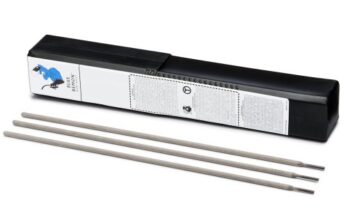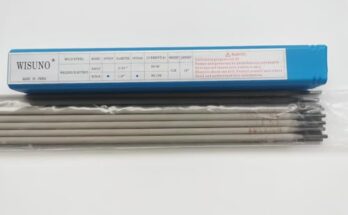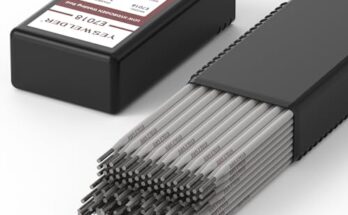Need to learn about welding? This guide will cover everything you need to know about a/c welding rods, from their purpose to their proper application. We’ll explore different types, applications, and best practices, ensuring you become confident in your welding projects.
Alternating current (AC) welding rods are consumable metal electrodes used
in alternating current (AC) arc welding processes. These rods melt and fuse with the base metal, creating a strong weld joint. Unlike direct current (DC) welding, which uses a constant flow of electrons, AC welding involves a current that periodically reverses direction. This reversal creates a cleansing action on the weld puddle, helping to remove impurities and improve the weld quality. This is particularly helpful when welding dirty or rusty materials where DC welding might struggle. Think of it like cleaning a grimy surface with a back-and-forth motion; the AC current constantly removes contaminants from the weld zone, resulting in a cleaner, stronger joint. The composition of the rod itself, often including fluxing agents, further contributes to this cleaning process, protecting the weld from atmospheric contamination during welding.
Key Features and Characteristics of A/C Welding Rods
A/C welding rods differ from their DC counterparts in several key ways. Their composition often incorporates a higher level of fluxing material which aids in the removal of oxides and other contaminants. The flux creates a protective layer shielding the molten weld metal from oxidation during the process. This fluxing is crucial because welding with AC inherently requires a cleaner metal preparation due to the alternating current’s effect on the weld puddle. The higher flux content often contributes to a slightly wider weld bead as well, making them less precise for detailed work compared to some DC rods. Depending on the specific metal being used, the rods also vary in diameter and coating type, influencing the heat output, penetration depth, and the overall quality of the weld. The diameter of the rod is selected based on the thickness of the materials being joined and the desired penetration depth, ensuring optimal performance.
Types of A/C Welding Rods and Their Applications
There’s a range of AC welding rods available for various applications, each with different properties designed to target specific metals and thicknesses. For instance, you’ll find rods optimized for mild steel welding, while others might be suited for cast iron or aluminum. The rod’s composition significantly impacts the weld quality and its suitability for different materials. Some common types include 6011, 6013, and 7014 which are popular choices for general-purpose welding. Each number represents a specific classification of the rod, indicating its properties like tensile strength, operating current, and weldability. This precise classification system is in place for a reason: selecting the correct rod is crucial for achieving a strong, safe, and reliable weld. Choosing the wrong one can result in poor-quality welds, structural weaknesses, and even potential safety hazards. For example, a rod designed for thin sheet metal used on thicker steel could lead to an insufficient weld or even burn through.
A/C vs. D/C Welding Rods: A Comparison
Understanding the Differences in Current
The fundamental difference lies in the type of electric current used. AC welding, as mentioned, uses alternating current that reverses polarity periodically, whereas DC welding uses direct current, which has a consistent flow. The polarity influences the characteristics of the arc and affects the weld bead’s appearance and properties. AC’s reversing polarity helps remove impurities from the weld zone, making it suitable for dirty or rusty metals where a clean weld is crucial. DC welding, on the other hand, offers more precise control over penetration and weld bead shape. This makes DC welding preferable when exact control over bead profile is essential, something less critical in many AC applications.
Applications Best Suited to A/C Welding
AC welding, with its inherent self-cleaning action, excels in welding materials that might be challenging for DC. This includes rusty, dirty, or slightly oxidized metals where a consistent, clean weld is necessary for structural integrity. You’ll often find AC welding used in applications where a high-quality weld is needed but a perfect surface preparation might be impractical or impossible. AC welding is extremely versatile and is used in a wide range of industries including construction, automotive repair, and manufacturing. This versatility stems from its ability to adapt to a range of materials and surface conditions. This is especially true for outdoor or industrial settings where material preparation is limited due to the environment and practical concerns.
Choosing the Right Rod for Your Application
Choosing between AC and DC welding rods depends largely on the type of metal being welded, the condition of the materials, and the desired quality of the weld. If you’re working with rusty or heavily oxidized metals, AC welding rods with their self-cleaning action are often the better choice. However, for applications requiring precise control and specific weld bead profiles, DC welding often provides more accurate results. Knowing your material, environment, and the weld specifications is essential in choosing the appropriate equipment and consumables. This choice impacts everything from the final weld quality to project safety and efficiency.
Factors Affecting A/C Welding Rod Performance
The Role of the Welding Machine
The welding machine plays a significant role in determining the performance of the A/C welding rod. The machine must be capable of supplying the correct voltage and amperage for the specific type and size of the rod being used. The machine’s settings directly impact the heat generated, the depth of penetration, and the quality of the weld bead. Using an improper setting can lead to a weak weld, a lack of penetration, or excessive spatter. It’s crucial to select the welding machine based on the welding rod specifications to guarantee optimal performance and safety. Some machines also offer adjustments to alter the waveform, influencing the arc characteristics and helping tailor the welding process to different needs.
The Significance of Proper Technique
Welding technique is just as important as the equipment. Using the correct welding technique ensures a clean and consistent weld. Improper technique can lead to inconsistent weld penetration, excessive spatter, or even a weak weld joint. Practice is crucial to mastering the skill of striking and maintaining the arc, controlling the welding speed, and ensuring consistent bead deposition. Proper technique directly translates to superior weld quality, avoiding potential safety hazards and material waste. Learning proper techniques often takes time, practice, and mentorship, but the reward is a significant improvement in weld quality and consistency.
Environmental Influences on Welding
Environmental conditions can greatly influence the success of an AC welding project. For instance, strong winds can blow the arc, leading to inconsistent welding. High humidity can also affect the stability of the arc and the quality of the weld. It’s crucial to account for these variables and take necessary precautions to compensate. Techniques like using a wind shield, controlling the humidity around the work area, and ensuring proper shielding gas protection, are all critical steps for a smooth and successful weld. Understanding and mitigating the influence of environmental conditions is essential in achieving consistent weld quality and ensuring the safety and reliability of the final product.
Safety Precautions When Using A/C Welding Rods
Personal Protective Equipment (PPE)
Safety should always be the top priority when welding. Always use appropriate personal protective equipment (PPE), including a welding helmet with an appropriate shade lens, welding gloves, and protective clothing. The intense heat and light produced during welding can cause severe burns and eye damage if proper precautions are not taken. Investing in high-quality PPE is an investment in your safety and well-being. Different levels of protection are available, so choosing the right equipment for the task is vital.
Proper Ventilation
Welding produces fumes and gases that can be harmful to your health. It’s vital to ensure adequate ventilation in the work area. This might involve working outdoors or using a local exhaust ventilation system to remove fumes from the welding area. Ignoring this aspect can lead to respiratory problems and long-term health complications. Always choose a well-ventilated workspace, or invest in appropriate ventilation systems for a safer environment. This also applies to the choice of location; welding in enclosed spaces without proper ventilation should be strictly avoided.
Fire Safety
Welding can be a potential fire hazard. Always ensure there’s a fire extinguisher nearby and clear the work area of any flammable materials. Sparks and hot metal can easily ignite combustible materials, so careful planning and preparedness are essential. Knowing how to use a fire extinguisher and having a clear plan in case of a fire can be lifesaving. This also includes regular maintenance checks on the equipment and the work area to minimize risks.
Selecting the Right A/C Welding Rod for Your Project
Understanding Rod Specifications
A/C welding rods are classified according to specific codes that indicate the type of metal they’re intended for, the welding process they’re designed for, and their mechanical properties. Understanding these codes is vital for selecting the correct rod for your project. These codes provide crucial information about the rod’s suitability for different materials, applications, and environmental conditions. Consulting a welding materials handbook or the manufacturer’s specifications will ensure the correct choice for your specific project requirements.
Factors Influencing Rod Selection
Several factors influence the choice of A/C welding rod. The metal type, thickness, and its surface condition all contribute to the selection process. The desired weld strength, the welding position, and even the environmental conditions, such as humidity and wind, also need to be considered. The selection process involves careful assessment of these factors to ensure optimal welding performance and safety. Often, trial and error, coupled with understanding the properties of the various rods, leads to the most effective selection.
Experimentation and Practice
Learning to weld often involves experimentation. Trying different rods, adjusting the welding machine settings, and practicing different techniques allows for hands-on experience. This process enables a welder to refine their skills and gain a deeper understanding of the intricacies of welding. Experimentation and practice are essential for developing proficiency and consistency in welding.
Advanced Techniques with A/C Welding Rods
Understanding Arc Control
Mastering arc control is crucial for producing high-quality welds. This involves maintaining a consistent arc length and ensuring smooth bead deposition. Practice is key to developing the skill and precision needed for effective arc control. Arc control influences the weld’s penetration, bead shape, and overall quality; a steady hand and understanding of the arc’s dynamics lead to strong, reliable welds.
Multi-Pass Welding
For thicker materials, multi-pass welding, or building up the weld in layers, might be necessary. This technique helps achieve proper penetration and a strong weld without overheating the base material. Multi-pass welding demands precise control and awareness of the heat input to each layer to ensure a homogenous and strong weld. It is a technique often used in structural welding applications to build a weld of sufficient thickness while managing heat input.
Tack Welding
Tack welding is a technique used to secure parts before the main weld is applied. This prevents movement and ensures the final weld is consistent and strong. Tack welds are small, temporary welds and their positioning can directly impact the strength and overall appearance of the final product. Precisely placed tack welds are essential for maintaining alignment in multi-piece welding tasks.
Troubleshooting Common A/C Welding Problems
Dealing with Excessive Spatter
Excessive spatter can be caused by improper welding technique, incorrect machine settings, or a flawed rod. Adjusting the amperage, improving technique, or switching to a different rod can resolve this issue. Excessive spatter negatively affects the aesthetic appeal and can compromise the strength of the weld. Identifying the root cause of excessive spatter is essential for corrective action.
Addressing Porosity in Welds
Porosity, or the presence of tiny holes in the weld, can be caused by contamination, improper shielding, or insufficient heat. Cleanliness, proper shielding gas, and correct amperage are crucial in preventing porosity. Porosity significantly weakens the weld and compromises its integrity. Understanding the causes of porosity is vital in ensuring a strong and reliable weld.
Correcting Lack of Penetration
Insufficient penetration can result from low amperage, improper welding technique, or an unsuitable rod. Adjusting the machine settings, improving technique, or selecting a rod with higher penetration capabilities can remedy this. Lack of penetration compromises the weld’s strength and integrity, making identification and correction of the underlying cause critical.
Frequently Asked Questions
What is a/c welding rod best for?
A/C welding rods are ideal for welding rusty, dirty, or slightly oxidized metals. The alternating current’s polarity reversal cleanses the weld puddle, removing impurities that would cause problems with DC welding. This makes them a versatile choice for applications where perfect surface preparation isn’t feasible. Learn more about the specifics of AC welding applications.
What are the different types of a/c welding rods?
Several types of a/c welding rods exist, each categorized by a numeric code (e.g., 6011, 6013, 7014). These codes signify specific properties like tensile strength, current requirements, and weldability. The choice of rod depends on the base metal, desired weld characteristics, and the welder’s experience. For detailed information, consult a welding materials handbook.
How do I choose the right amperage for a/c welding?
The correct amperage depends on the rod diameter and the thickness of the material being welded. Too low an amperage leads to insufficient penetration, while too high an amperage causes excessive spatter and potential burn-through. Consult the rod’s specifications and the welding machine’s manual for recommended settings. Experimentation under controlled conditions is always beneficial, but always prioritize safety.
What safety precautions should I take when using a/c welding rods?
Always wear appropriate PPE, including a welding helmet, gloves, and protective clothing. Ensure adequate ventilation to remove harmful fumes. Keep a fire extinguisher nearby and clear the area of flammable materials. Familiarize yourself with the safety guidelines outlined in the welder’s manual. Your safety and wellbeing is paramount.
Can I use a/c welding rods on all metals?
While versatile, A/C welding rods are not suitable for all metals. Their effectiveness depends heavily on the base metal’s composition and surface condition. Certain metals might require DC welding for optimal results. Always refer to the rod specifications and recommended applications to confirm compatibility with your project materials.
How important is the coating on an a/c welding rod?
The coating plays a critical role in protecting the weld from atmospheric contamination and improving weld quality. It also helps to stabilize the arc and control the penetration depth. Different coatings have different properties; choosing the correct coating is crucial for the welding process. It’s almost as important as choosing the correct current type.
What are the common problems encountered when using a/c welding rods, and how are they resolved?
Common problems include excessive spatter, porosity, and lack of penetration. These issues can stem from incorrect amperage, poor technique, contamination, or improper shielding. Addressing these problems involves carefully adjusting machine settings, refining technique, cleaning the weld area, and possibly using a different rod. Always strive for consistent and repeatable outcomes.
Final Thoughts
Mastering the use of a/c welding rods requires understanding their unique characteristics, the welding process itself, and maintaining a vigilant focus on safety. Through practice, understanding of the different rod types, and careful attention to detail, you can achieve high-quality welds suitable for a multitude of projects. Remember, consistent practice and a commitment to safety are paramount for success in welding. So grab your equipment, follow the safety guidelines, and start practicing your welding techniques!


